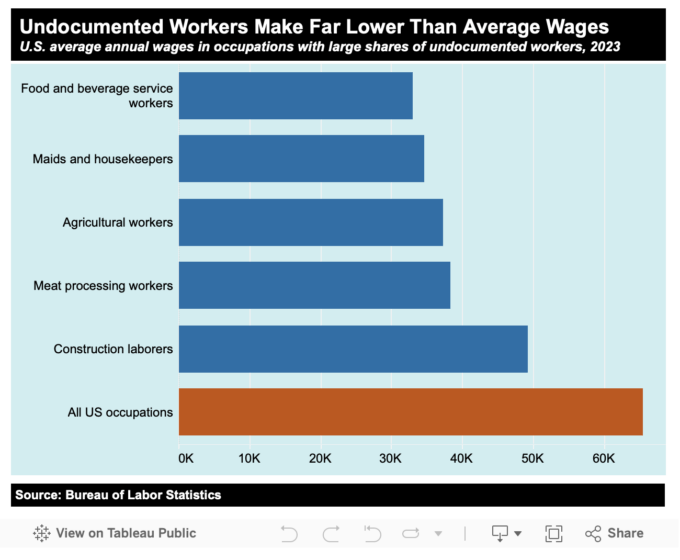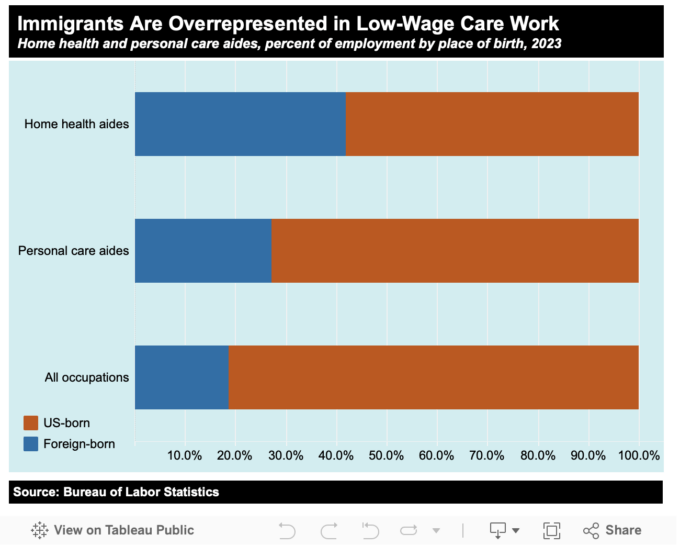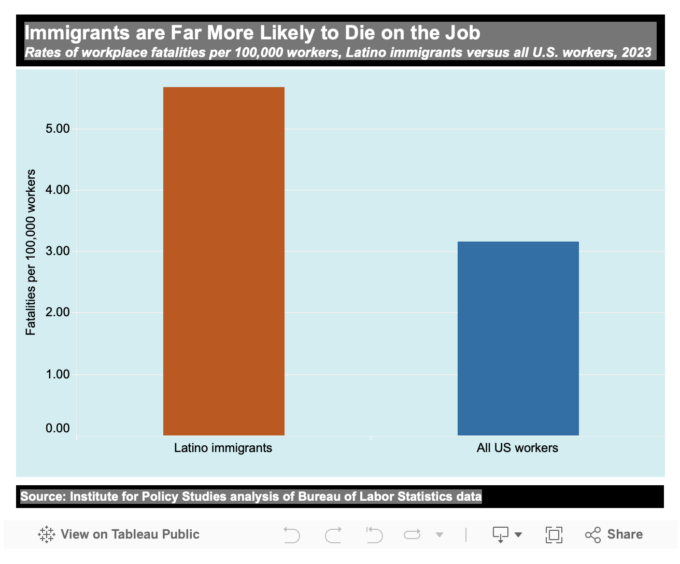Immigrant Worker Exploitation in America in Four Charts
President Trump is now promoting $5-million “gold card” tickets to U.S. citizenship for wealthy foreigners, with no obligation to create good jobs for Americans. Many immigrants, meanwhile, face serious economic hardship and exploitation — despite making enormous contributions to our economy.

The undocumented immigrants Trump wants to deport make up an estimated 4.9 percent of the U.S. workforce. The Bureau of Labor Statistics does not disaggregate data on undocumented workers, but Institute for Policy Studies analysis of BLS dataillustrates that occupations with large undocumented workforces pay far less than the average annual wage. For example, agricultural workers, an estimated 15.1 percent of whom are undocumented, make an average of $37,370 annually, considerably less than the $65,470 average for all U.S. occupations. And because so many undocumented workers live in the shadows, even these figures likely overestimate their actual wages.

Immigrants (documented and undocumented) make up a disproportionately large share of care jobs that are essential to our society and yet remain very low paid. According to the Bureau of Labor Statistics, 42 percent of home health aides and 27 percent of personal care aides are foreign born. While hard data on their immigration status remains scarce, one 2020 study estimates that undocumented workers make up 6.9 percent of home health aides and 4.4 percent of personal care aides.
Women make up the vast majority of these care jobs, including 87.2 percent of home health aides and 79.8 percent of personal care aides, despite comprising only 46.9 percent of the total U.S. workforce. The median annual salary for these occupations stood at just of $33,530 in 2023, well below the overall U.S. median of $48,060.
Because of low pay and difficult conditions, home health and personal care aides face severe staffing shortages and are projected to have the highest number of job openings annually over the next decade. Immigrant women, marginalized by both gender and immigration status, play a critical yet undervalued role in taking care of the nation’s children, elderly, and others with special care needs.

To encourage workers to report labor violations, the U.S. Department of Labor does not ask victims of suspected wage theft about their immigration status. However, Center for Public Integrity analysis of industries with higher percentages of foreign-born workers shows a clear pattern of immigrant exploitation. Major industries with significant numbers of immigrant workers and high wage theft rates include restaurants, hotels, and landscaping and building maintenance.
Undocumented workers are particularly vulnerable to wage theft as they are often the least likely to report violations due to fear of retaliation, job loss, or exposure of their immigration status. Many also endure workplace abuse that goes unreported, including employer threats of deportation and verbal or physical mistreatment. These hidden forms of exploitation allow employers to exert control over vulnerable workers, deepening economic inequalities. By exploiting fear and insecurity, employers can steal wages with little consequence, ultimately padding the profits of corporations and their wealthy business owners.

In 2023, nearly six out of every 100,000 foreign-born Latino workers suffered a fatal workplace injury, according to Institute for Policy Studies analysis of Bureau of Labor Statistics data. Among all U.S. workers, that rate stood significantly lower, at just over three out of 100,000 workers.
Why the contrast? Immigrants — particularly the undocumented — often take on the most dangerous jobs. The Center for American Progress has estimated that undocumented immigrants make up 23 percent of the construction workforce. Because of their precarious status, these workers have less leverage to demand proper safety equipment and standards. Of workplace deaths among foreign-born Latinos, 37.5 percent occurred in the construction industry.
These figures highlight a harsh reality: immigrant workers are among the most vulnerable in the U.S. workforce, often placed in the most dangerous jobs with inadequate protections.
Sarah Anderson directs the Global Economy Project and co-edits Inequality.org at the Institute for Policy Studies. Reyanna James is an Inequality Research and Editorial Associate at the Institute for Policy Studies.
No comments:
Post a Comment